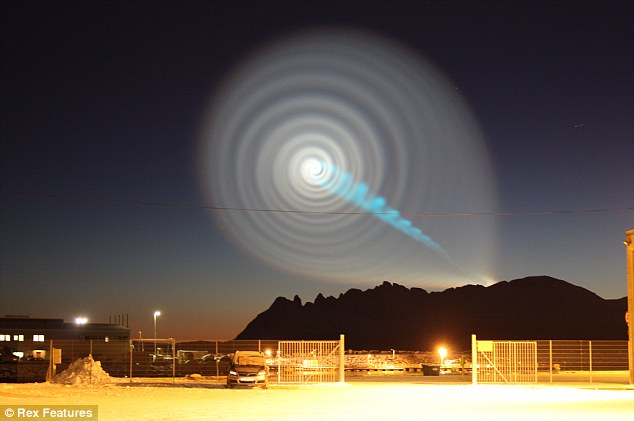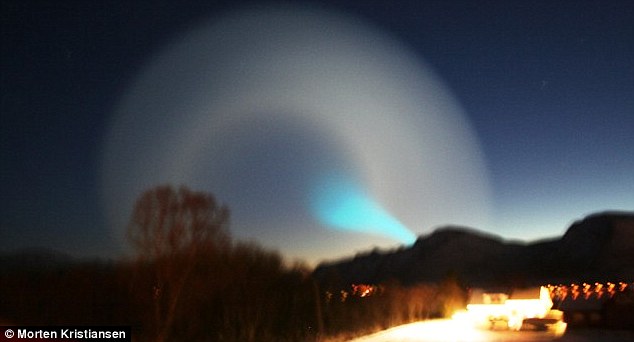Any ideas?
Norway’s mysterious spiral blue light display: Was it a failed Russian Bulava missile test?

Strange spiral: Residents in northern Norway were left stunned after the lightshow, which almost looked computer-generated, appeared in the skies above them

Confusion: The Norwegian Meteorological Institute was flooded with calls after the light storm
What’s blue and white, squiggly and suddenly appears in the sky?
If you know the answer, pop it on a postcard and send it to the people of Norway, where this mysterious light display baffled residents yesterday.
Speculation was increasing today that the display was the result of an embarrassing failed test launch of a jinxed new Russian missile.
The Bulava missile was test-fired from the Dmitry Donskoi submarine in the White Sea early on Wednesday but failed at the third stage, say newspapers in Moscow today.
Troms? Geophysical Observatory researcher Truls Lynne Hansen agreed, saying the missile had likely veered out of control and exploded, and the spiral was light reflecting on the leaking fuel.
But last night Russia denied it had been conducting missile tests in the area.
A Moscow news outlet quoted the Russian Navy as denying any rocket launches from the White Sea area.
Norway should be informed of such launches under international agreements, it was stressed.
However this morning media reports claimed a missile had indeed been launched from the White Sea. Test firings are usually made from the White Sea, close to the Norwegian Arctic region.
Kommersant newspaper reported today that a test-firing before dawn on Wednesday coincided with the light show in the northern sky.
It also emerged today that Russia last week formally notified Norway of a window when a missile test might be carried out.
This included a seven hour period early on Wednesday at the time when the lights were seen.
The submarine Dmitry Donskoy went to sea on Monday, ahead of the test, and some reports suggest the vessel is now back in port.
A Russian military source said today that ‘the third stage of the rocket did not work’.
The Russian Defence Ministry, with characteristic secrecy, has so far been unavailable for comment.
A Bulava missile is fired from a submarine in this undated file photo. Russia has yet to confirm if a similar test launch was behind the mystery lights seen over Norway yesterday
A Bulava missile is fired from a submarine in this undated file photo. Russia has yet to confirm if a similar test launch was behind the mystery lights seen over Norway yesterday
The Bulava, despite being crucial to Russia’s plans to revamp its weaponry, is becoming an embarrassment after nine failed launches in 13 tests, prompting calls for it to be scrapped.
In theory, it has a range of 5,000 miles and could carry up to ten nuclear weapons bound for separate targets.
A previous failure in July forced the resignation of Yury Solomonov, the director of the Moscow Institute of Thermal Technology which is responsible for developing the missile.
However, he is now working as chief designer on the jinxed project.
The Norwegian Meteorological Institute was flooded with telephone calls after the light storm yesterday morning.
Totto Eriksen, from Tromsø, told VG Nett: ‘It spun and exploded in the sky,’
He spotted the lights as he walked his daughter Amalie to school.
He said: ‘We saw it from the Inner Harbor in Tromsø. It was absolutely fantastic.
‘It almost looked like a rocket that spun around and around and then went diagonally down the heavens.
‘It looked like the moon was coming over the mountain, but then came something completely different.’
Celebrity astronomer Knut Jørgen Røed Ødegaard said he had never seen anything like the lights.
He said: ‘My first thought was that it was a fireball meteor, but it has lasted far too long.
‘It may have been a missile in Russia, but I can not guarantee that it is the answer.’
Air traffic control in Troms? claimed the light show lasted ‘far too long to be an astronomical phenomenon’.
See video showing part of the light here, and below
By
Last updated at 9:32 AM on 10th December 2009
Source: Daily Mail